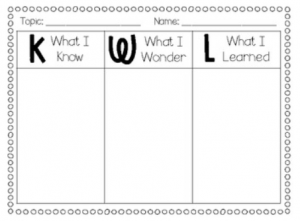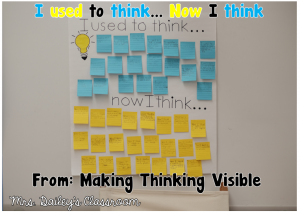Strategies for Engagement, Understanding,
and Independence in the CrWr Classroom, with current TA and educator Amy Higgins
Are you tired of the same-old same-old instructional activities? Wondering how to facilitate productive discussions in the classroom? Seeking suggestions for meaningful, engaging lessons?
Making Thinking Visible: How to Promote Engagement, Understanding, and Independence for All Learners by Ron Ritchhart, Mark Church, and Karin Morrison is the resource you need! This book offers offers user-friendly strategies that help guide your students’ thinking and structure the class conversations. You can also find many of these instructional activities detailed online:
A few years ago, while teaching in the K – 12 system, I was lucky enough to attend a professional development session facilitated by Ron Ritchhart, co-author of Making Thinking Visible and Senior Research Associate at the Harvard Graduate School of Education’s Project Zero. In this session, I learned that “routine” is a key word when it comes to Visible Thinking. As a teacher, my impulse is to continually introduce new strategies, lesson formats, and learning activities. I want to keep my students interested, after all! However, when certain instructional activities become routine, teaching and learning improve. Once routines are established, I spend less time giving instructions and more time prompting students to go deeper in their thinking. Similarly, learners focus less on understanding the expectations of the activity, and more time grappling with the subject matter itself.
The Visible Thinking routines detailed below are incredibly simple, flexible, and adaptable to various contexts. I have used these routines in Kindergarten, asking students, “What do you know about our playground environment? What do you wonder?” And, later, “What have you learned?” I’ve used the routines in Grade 2, asking students what they observe, think, and wonder when viewing images of various Canadian landmarks. I’ve used them in Grade 5, guiding students through “think-pair-share” exercises as part of an inquiry into immigration. And they work in the post-secondary classroom too!
Here is an outline of some of the core Visible Thinking routines, along with suggestions for using them in the Creative Writing classroom:
-
Interpretation & Justification: What Makes You Say That?
This is a simple strategy for guiding students’ engagement with a piece of writing — whether they’re workshopping a piece written by a peer or studying an exemplar of a particular genre or form.Simply ask the students two questions: “What’s going on (or, What do you notice) in this piece of writing?” (Interpretation). Followed by, “What makes you say that?” (Justification).These simple prompts are a quick and easy way of encouraging students to expand upon their ideas and stretch their thinking to the next level. And it’s a great “back pocket” response for those moments when you’re not quite sure what to say!
-
KWL
K stands for “What do you KNOW about this topic?”; W stands for “What do you WONDER?”; and L stands for “What have you LEARNED?”
When you’re introducing a topic — poetic devices! elements of fiction! types of creative nonfiction! — ask students to record their responses to the first two questions; they can do this individually, in pairs, or in small groups. After exploring the topic, ask students to fill in the third column, sharing their learning. This is a low-prep exercise that encourages reflection, and it works for any topic.

-
Think-Pair-Share
When introducing a topic of discussion, allow students some time to silently think about their answer. This is particularly important for students who need a bit more time to formulate a response.Then, invite students to discuss their idea with a partner. This ensures that every student participates actively, even those who may hesitate to speak in front of the whole group. Also, it gives students a chance to test out their viewpoint and articulate their thoughts, while possibly revising or refining their ideas in response to their classmate’s questions and comments.Finally, offer students an opportunity to share with the whole group. This discussion format is very effective for encouraging more reticent members of the group to speak up!
-
I used to think … Now I think …
Another fast, simple, end-of-unit reflection: ask students to respond in writing to the prompts “I used to think …” and “Now I think …”. This encourages students to identify what they’ve learned and the ways in which their thinking has changed. After having students record their responses in writing, you may ask them to share aloud in small groups or with the class.One variation: have students record their ideas on sticky notes, then combine them to make a class chart, as pictured below:

-
Observe, Think, Wonder
This is another strategy to guide students’ encounters with literature, whether they’re reading a classmate’s work or looking at an example of a published piece. Simply ask them to reflect upon the following questions: “What do you observe?” “What do you think?” and “What do you wonder?” These prompts can help you guide students to look carefully at the work, develop thoughtful interpretations, and generate helpful and provocative questions.
-
Compass Points
Introducing students to a new idea, explaining an assignment, or helping the group work through a problem? Keep in mind the four compass points:
E – What EXCITES you about this idea / project / issue?
W – What WORRIES you?
N – What do you NEED to know?
S – What is your STANCE on this? And / or, what SUGGESTIONS do you have to offer?
Whether discussed aloud or offered as writing prompts, these questions will help to guide the conversation in a productive direction!
For more ideas, visit the Visible Thinking website:
Happy teaching!
